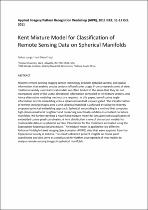 ResearchSpace
ResearchSpace
Kent mixture model for classification of remote sensing data on spherical manifolds
JavaScript is disabled for your browser. Some features of this site may not work without it.
- ResearchSpace
- →
- Research Publications/Outputs
- →
- Conference Publications
- →
- View Item
| dc.contributor.author |
Lunga, D

|
|
| dc.contributor.author |
Ersoy, O

|
|
| dc.date.accessioned | 2012-05-29T08:43:46Z | |
| dc.date.available | 2012-05-29T08:43:46Z | |
| dc.date.issued | 2011-10 | |
| dc.identifier.citation | Lunga, D and Ersoy, O. Kent mixture model for classification of remote sensing data on spherical manifolds. The Applied Imagery Pattern Recognition Workshop, Cosmos Club, Washington, DC, USA, 11-13 October 2011 | en_US |
| dc.identifier.isbn | 978-1-4673-0215-9 | |
| dc.identifier.uri | http://www.computer.org/csdl/proceedings/aipr/2011/0215/00/06176337-abs.html | |
| dc.identifier.uri | http://ieeexplore.ieee.org/stamp/stamp.jsp?tp=&arnumber=6176337 | |
| dc.identifier.uri | http://hdl.handle.net/10204/5879 | |
| dc.description | Copyright: 2011 IEEE. This is an ABSTRACT ONLY. | en_US |
| dc.description.abstract | Modern remote sensing imaging sensor technology provides detailed spectral and spatial information that enables precise analysis of land cover usage. From a research point of view, traditional widely used statistical models are often limited in the sense that they do not incorporate some of the useful directional information contained in the feature vectors, and hence alternative modeling methods are required. In this paper, use of cosine angle information and its embedding onto a spherical manifold is investigated. The transformation of remote sensing images onto a unit spherical manifold is achieved by using the recently proposed spherical embedding approach. Spherical embedding is a method that computes high-dimensional local neighborhood preserving coordinates of data on constant curvature manifolds. The authors further develop a novel Kent mixture model for unsupervised classification of embedded cosine pixel coordinates. A Kent distribution is one of the natural models for multivariate data on a spherical surface. Parameters for the model are estimated using the Expectation-Maximization procedure. The mixture model is applied to two different Airborne Visible/Infrared Imaging Spectrometer (AVIRIS) data that were acquired from the Tippecanoe County in Indiana. The results obtained present insights on cosine pixel coordinates and also serve as a motivation for further development of new models to analyze remote sensing images in spherical manifolds. | en_US |
| dc.language.iso | en | en_US |
| dc.publisher | IEEE | en_US |
| dc.relation.ispartofseries | Workflow;7645 | |
| dc.subject | Remote sensing data | en_US |
| dc.subject | Kent mixture model | en_US |
| dc.subject | Spatial information | en_US |
| dc.subject | Remote sensing images | en_US |
| dc.subject | Spherical manifolds | en_US |
| dc.title | Kent mixture model for classification of remote sensing data on spherical manifolds | en_US |
| dc.type | Conference Presentation | en_US |
| dc.identifier.apacitation | Lunga, D., & Ersoy, O. (2011). Kent mixture model for classification of remote sensing data on spherical manifolds. IEEE. http://hdl.handle.net/10204/5879 | en_ZA |
| dc.identifier.chicagocitation | Lunga, D, and O Ersoy. "Kent mixture model for classification of remote sensing data on spherical manifolds." (2011): http://hdl.handle.net/10204/5879 | en_ZA |
| dc.identifier.vancouvercitation | Lunga D, Ersoy O, Kent mixture model for classification of remote sensing data on spherical manifolds; IEEE; 2011. http://hdl.handle.net/10204/5879 . | en_ZA |
| dc.identifier.ris | TY - Conference Presentation AU - Lunga, D AU - Ersoy, O AB - Modern remote sensing imaging sensor technology provides detailed spectral and spatial information that enables precise analysis of land cover usage. From a research point of view, traditional widely used statistical models are often limited in the sense that they do not incorporate some of the useful directional information contained in the feature vectors, and hence alternative modeling methods are required. In this paper, use of cosine angle information and its embedding onto a spherical manifold is investigated. The transformation of remote sensing images onto a unit spherical manifold is achieved by using the recently proposed spherical embedding approach. Spherical embedding is a method that computes high-dimensional local neighborhood preserving coordinates of data on constant curvature manifolds. The authors further develop a novel Kent mixture model for unsupervised classification of embedded cosine pixel coordinates. A Kent distribution is one of the natural models for multivariate data on a spherical surface. Parameters for the model are estimated using the Expectation-Maximization procedure. The mixture model is applied to two different Airborne Visible/Infrared Imaging Spectrometer (AVIRIS) data that were acquired from the Tippecanoe County in Indiana. The results obtained present insights on cosine pixel coordinates and also serve as a motivation for further development of new models to analyze remote sensing images in spherical manifolds. DA - 2011-10 DB - ResearchSpace DP - CSIR KW - Remote sensing data KW - Kent mixture model KW - Spatial information KW - Remote sensing images KW - Spherical manifolds LK - https://researchspace.csir.co.za PY - 2011 SM - 978-1-4673-0215-9 T1 - Kent mixture model for classification of remote sensing data on spherical manifolds TI - Kent mixture model for classification of remote sensing data on spherical manifolds UR - http://hdl.handle.net/10204/5879 ER - | en_ZA |





